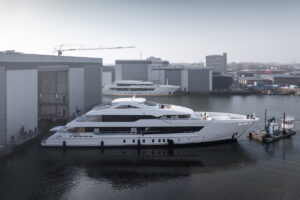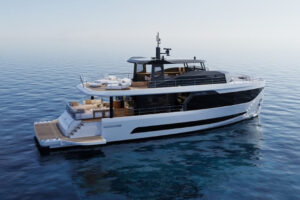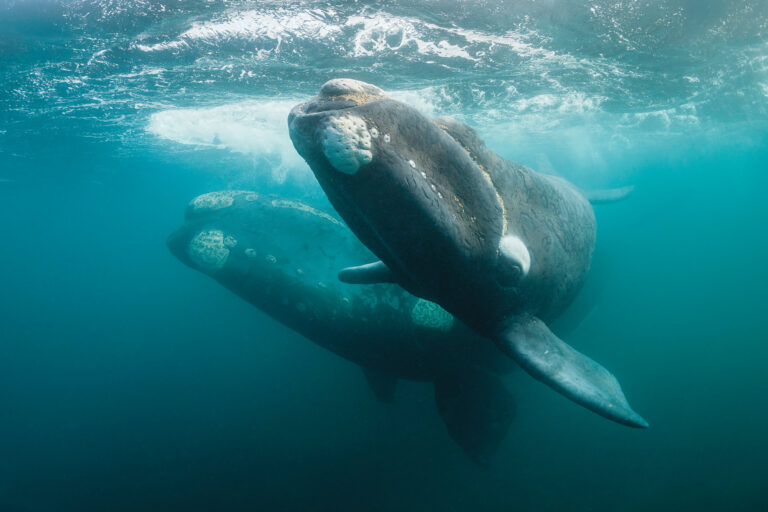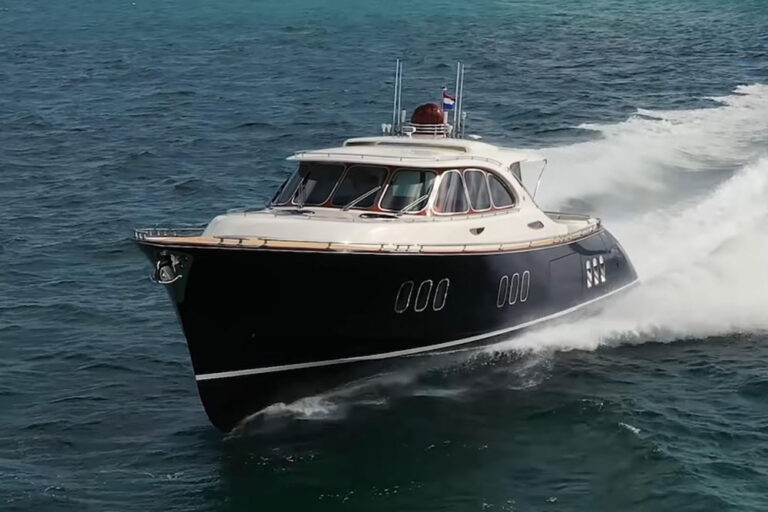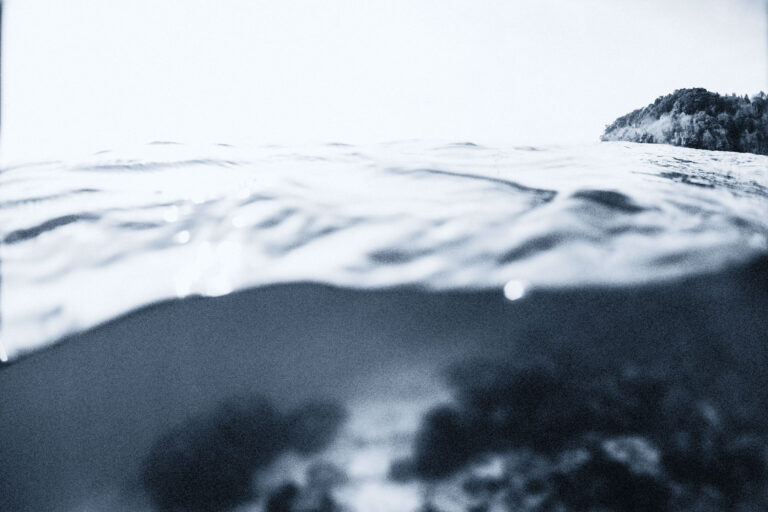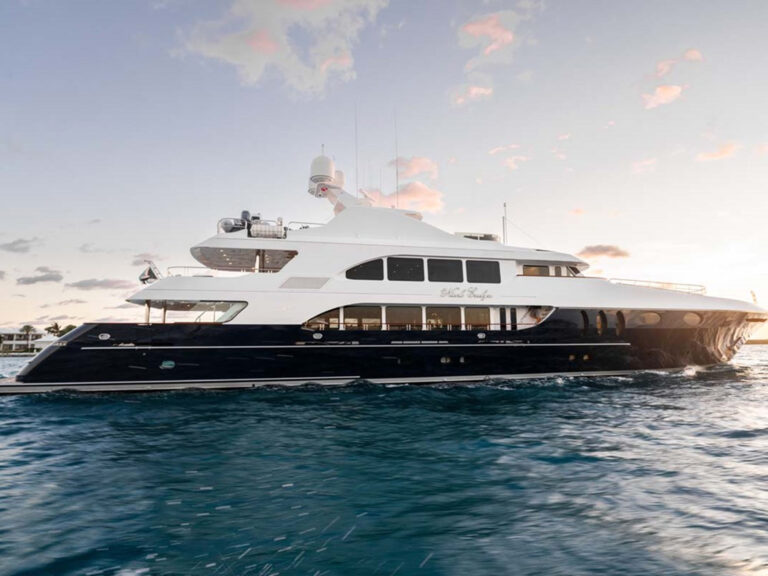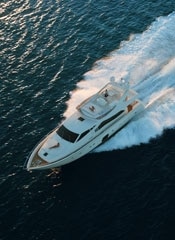
Ferretti 731
Ah, the Italian Mediterranean! That glamorous place of blue skies and calm seas that we know so well. Or think we do, just as we think we know the look of the boats, products of a languid and storied playground for Dolce Vita types. As in the myth of Athena, all Italian boats are always stepping out of Zeus’ forehead like full-grown goddesses. It’s ‘in the blood,’ people say.
But just as it is not always summer in Italy (take my word for it), there are also beautiful boats that are hard-fought elaborations and evolutions of classic design campaigns. That was the situation when I went to La Spezia for a sea trial on the latest product from Ferretti. La Spezia itself is a good example of the ‘real’ Italy: Certainly not the world’s most beautiful port, having been developed around a naval base and a commercial harbor, its working area is modern and brash. But nearby there are some beautiful seaside villages, steeped in history, where it is easy to see what attracted the Roman Legions here and why they built massive forts to defend the place. Take this beauty amid raw industrial power, supplement it with the presence of many wonderful restaurants, and you arrive at just the ambience for which this new Ferretti was designed.
Like the evolving character of La Spezia, the design of the Ferretti 731 has moved on from the builder’s earlier conservative approach. The classic styling that was so much a part of the Ferretti legend has now evolved a more modern sporting look. There are also a number of innovations in this landmark design that bring the 731 into the forefront of modern yacht styling.
Notable among these is the way that the flybridge helm has been moved from its traditional position at the front of the fly to a more central position. Here there is a control console with its own wind deflector. This position makes so much sense. First it gives the driver more chance to stay in contact with the rest of the guests because they will tend to be in front rather than behind him. Also, the visibility aft is much better, which makes docking stern-to easier. With this layout, the flybridge has in fact been reversed so that the sun bed is forward of the helm and the dining/seating area is behind. An electrically powered Bimini comes out from the arch mast to provide a very effective sunshade; finally, there is a bar and barbecue cabinet.
The 731 has very large side windows in the hull. These have become a feature of larger yachts; this is one of the smallest yachts that I have come across to have these windows, which bring a huge amount of light to the amidships master stateroom. There is even a panoramic view from the bed, although it is restricted on the port side by the en suite bathroom. However, the bathroom itself gains a view, though in port you would probably pull the blinds most of the time.
Other highlights show how the Ferretti team is moving forward. There is a lighter look to the interior, thanks to teak with a tactile matte finish that has replaced the heavily lacquered cherry wood paneling of old. Lighter colors are also used for the leather settees; overall, darkness has been replaced by light to give a sharper, more modern feel to the interior.
Outside there is also a sharper, lower line with the central flybridge console moving the focus further aft to produce a more sporting profile. The low bulwarks are topped by a teak capping and then by stainless steel rails that help to reduce the depth of the hull. Forward there is a massive sunbed, while aft there is the innovation of a fold-out bench seat to create what Ferretti describes as a ‘mini beach’-virtually at sea level on the swim platform. (For safety this is stowed away when at sea.)
There is more sunbathing space in the cockpit, with a teak table is that is large enough to seat eight. The mooring fittings are hidden away under hinged covers; I very much liked the storage bins provided here for the mooring ropes. Another innovation for Ferretti is the provision of a swinging rather than a sliding door into the saloon. At sea, a swinging door is much easier and safer to use.
In the lounge area two symmetrical L-shaped settees face each other with two glass-topped tables between. The plasma screen TV is housed in a base forward of the seating and acts as a separator between the lounge and dining areas, the latter being one step up in deck level. Here is a beautiful glass-topped table that can seat eight. The compact galley is conveniently close but in a separate compartment. This has an outside door for crew access and a skylight for good natural light. Sideboards run each side of the dining table and on the port side there is an open ladder to the flybridge.
Unusual for this class of yacht, the pilothouse is separated from the accommodation; this prevents any view astern. The finish here is black leather, reducing reflections. On the port side there is a small table and guest seating. The two seats at the helm face the now familiar three-screen information layout comprising radar, electronic chart and monitoring system. The latter is the Naviop system that Ferretti has adopted; the main engine monitoring is by very clear MAN displays.
Below are the stateroom in addition to the master. These are all en suite cabins, though their bathrooms are not on the same grand scale. For these cabins there are portholes instead of large windows; they do share, however, a very high quality finish with rich fabrics. The effect is both restful and luxurious.
The engineroom space is generous, though the same cannot be said for the two-crew cabins squeezed in aft. Space is tight here and is partly taken up by the laundry equipment in the access lobby. The test boat was fitted with a pair of the latest electronic diesels from MAN that each produces 1,550 hp; the 1,360 hp units are an option. The speed difference between these options is around 2 1/2 knots.
Propulsion is provided by conventional shaft and propellers with no semi-tunnels for the props. Combined with the shallow 12-degree deadrise hull this proved to be an effective combination, although the pronounced chines on the hull did tend to add a stiffness to the ride in waves. This is a hull that will give effective performance at sea in a variety of conditions-it certainly worked well in the swell left in the aftermath of a storm on the day we tried it.
For those who know the Ferretti history, it comes as no surprise that the company understands the market it serves very well. Their first boat was a motorsailer, launched in 1971 as the sailing phenomenon swept popular cruising waters worldwide. Nine years later they transferred the skills and expertise garnered from building sailboats of various sizes and began building luxury motoryachts for the rich and famous. By the end of the 1980s, they were building yachts up to 19 meters long in their facility in Forli, Italy, and their name was synonymous with style and leading-edge technology.
This new style from Ferretti brings their designs right up-to-date, yet they have retained the classic Ferretti quality and style. For a good all-round yacht this new 731 will be hard to beat-and as we can now watch out for the same style innovations showing up on a range of future Ferrettis, it may well be a prelude to a new set of myths about the origins of future generations of Italian boats. n
Contact: Ferretti S.p.A., (011) 39 0543474411; www.ferretti-yachts.com.
MarineMax, (888) 71-YACHT; www.marinemax.com.

